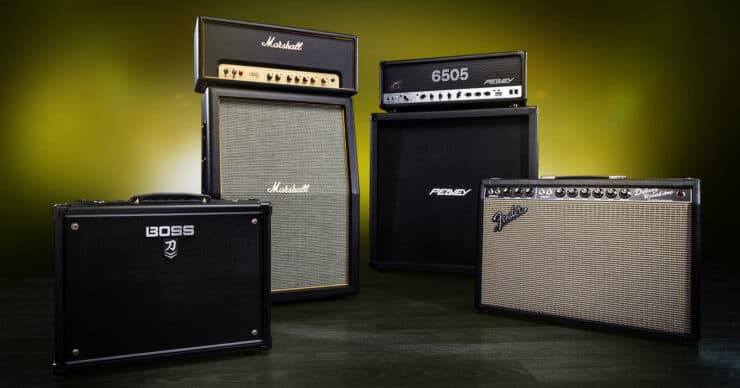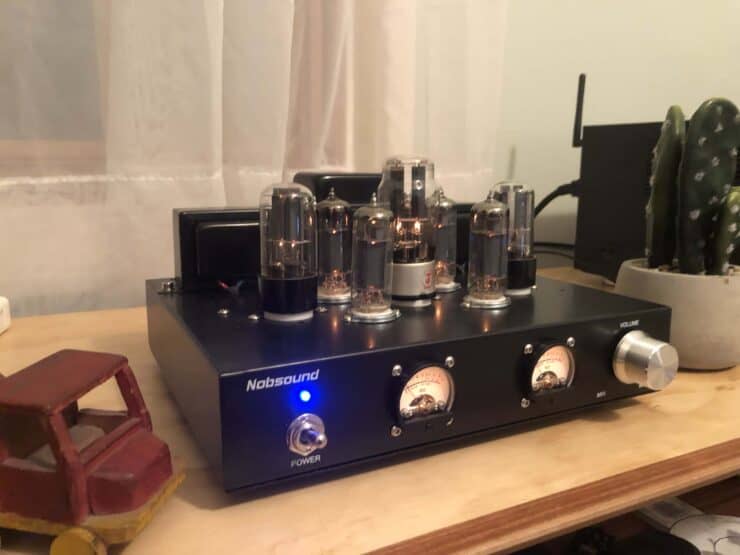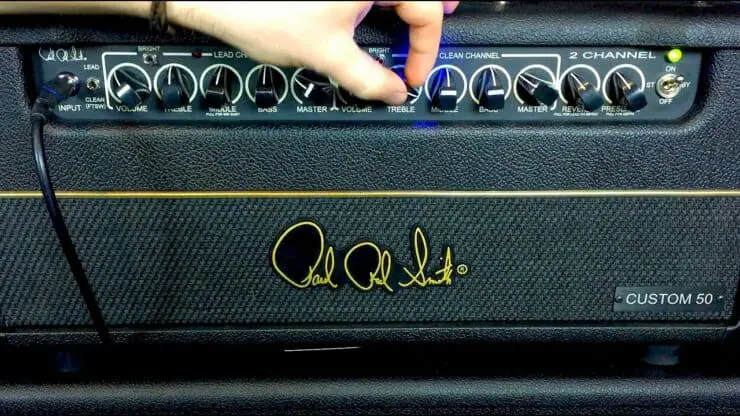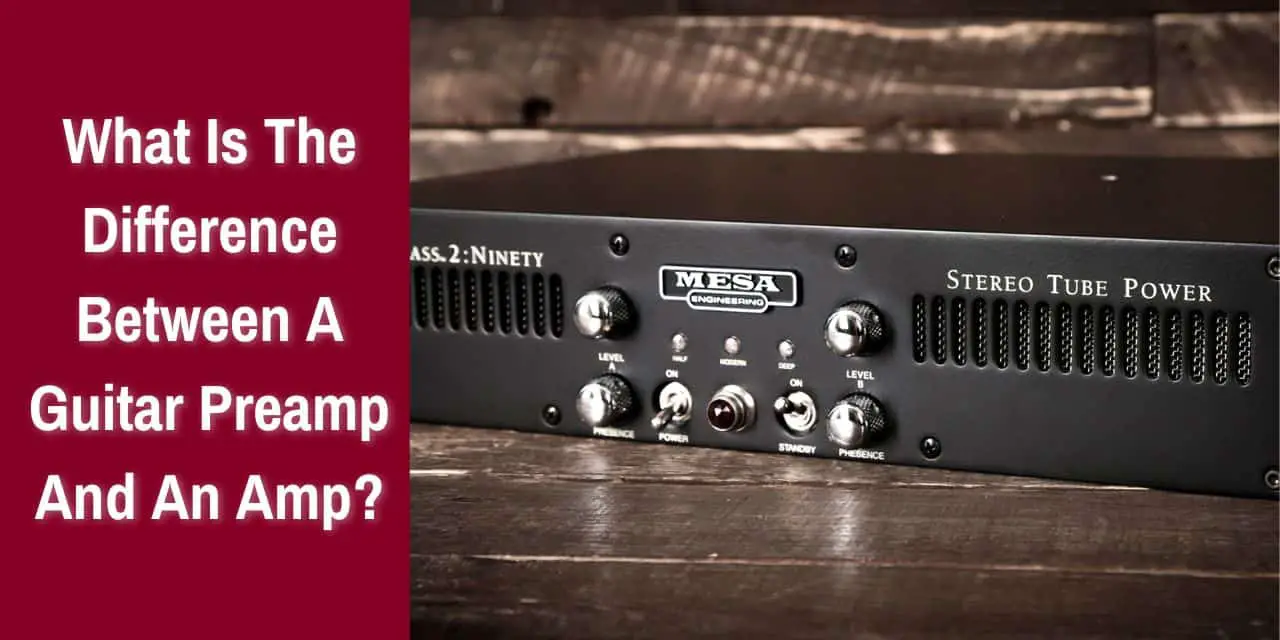Greetings fellow guitarists! Have you ever been curious about the difference between a guitar preamp and an amp? Well, if you’re looking for the answers, then you’ve come to the right place! In this article, we’ll cover the basics of guitar preamps and amps, and explain how they affect the sound of your instrument. Read on to learn more and become an expert on the topic!
What is a guitar preamp and how does it affect the sound?
Guitar preamps are essential components of a guitar’s signal chain responsible for shaping and enhancing the sound of the instrument before it reaches the amp. Understanding the role of a preamp and how it affects the guitar’s sound contributes greatly to crafting your desired tone.
A preamp, short for preamplifier, is an electronic circuit that amplifies weak signals from a guitar’s pickups and prepares them for further amplification. It serves as the initial stage of the signal chain where the guitar’s raw signal is modified and optimized before it is sent to the power amplifier.

Role of a guitar preamp
Here is the role that a guitar preamp plays in shaping sound –
One of the primary functions of a guitar preamp is to boost the relatively weak electrical signal generated by the guitar’s pickups. By amplifying the signal, the preamp will increase its level to a suitable level for further processing and amplification.
Preamps often include tone control circuits, such as equalizers, which allow guitarists to shape the frequency response of their instrument. EQ controls generally consist of bass, treble, and midrange adjustments, enabling precise manipulation of specific frequency ranges. By boosting or attenuating certain frequencies, guitarists can achieve an impressive range of tonal variations, from warm and mellow to bright and cutting.
>>> Click here to read our review about the Top 15 Best Guitar Preamps <<<
Many guitar preamps feature gain or overdrive controls, which introduce distortion or saturation to the signal. These controls are widely responsible for creating the desired level of crunch, distortion, or overdriven tones. By adjusting the gain, guitarists will be able to dial in the amount of drive they prefer, ranging from clean and pristine to heavily saturated and distorted tones.
Another critical role of a preamp is to match the impedance between the guitar’s pickups and the input stage of the amp. This ensures efficient signal transfer and minimizes loss of high-frequency content and overall signal degradation. Proper impedance matching contributes to a much more defined and articulate sound.
In addition to tone control and amplification, preamps might also include various signal conditioning features like compression, noise gates, or built-in effects. These additional features can help to reduce unwanted noise, smooth out dynamics, or add a touch of modulation or ambiance to the signal.
How does a preamp affect the sound?
A guitar preamp plays an important role in shaping the overall sound of the guitar. By modifying the signal’s amplitude and frequency response and introducing gain or distortion, a preamp will significantly affect the tonal characteristics and dynamics of the guitar.
Different preamps have unique sonic signatures and tonal characteristics. Some preamps might produce a clean, transparent sound that faithfully reproduces the guitar’s natural tone whereas others might impart coloration, warmth, or vintage-style saturation. The choice of the preamp can influence the overall character and personality of the guitar’s sound greatly.
What is a guitar amp and how does it affect the sound?
The guitar amp is another important component of the electric guitar setup. It plays a key role in shaping the sound and tonal characteristics of the guitar. While it can often be overshadowed by the guitar itself, an amp can greatly influence the sonic palette, adding depth, texture, and character to the guitarist’s playing.
A guitar amp, short for amp, is an electronic device designed for amplifying the signal produced by an electric guitar. It consists of various components, including preamp circuits, power amps, and speakers. The primary function of an amp is to increase the signal from the guitar’s pickups to a level that can be heard at a desired volume level.
Role of a guitar amp
One of the significant functions of a guitar amp is its ability to shape the tonal characteristics of the instrument. Guitar amps generally come equipped with tone controls, which allow the guitarist to easily manipulate the frequencies and tailor the tone to their liking. The controls can enhance or attenuate specific frequency ranges, allowing the guitarist to craft their desired tones.
Guitar amps can also incorporate built-in effects like reverb, delay, distortion, or modulation effects like chorus or tremolo. These effects can add depth, texture, and character to the guitar’s sound, expanding the sonic possibilities for the guitarist. By incorporating different effects into your playing, you’ll be able to create atmospheres, add intensity, or signature sounds associated with different genres or iconic guitarists.
In addition to tonal shaping and effects, a guitar amp can also determine the power and volume of the instrument. Amp wattage affects the overall output level, allowing guitarists to easily achieve clean tones at lower volumes or push the amp into overdrive for distortion and crunch at higher volumes. The speaker configuration and cabinet design also contribute to the projection and dispersion of sound.
How does an amp affect the sound?
The interaction between the guitar and amp will be important for achieving the desired sound. Different types of guitars, pickups, and playing techniques respond uniquely to various amp settings. For instance, single-coil pickups might yield a brighter sound with more twang whereas humbuckers can deliver a thicker and heavier tone. Experimenting with different combinations of guitars and amps will allow you to discover your signature sound.

What is the difference between a guitar preamp and an amp?
When it comes to crafting the perfect guitar sound, understanding the distinctions between a preamp and a guitar amp will be important. While both of them play important roles in the signal chain, they serve different purposes and offer distinct features. Here are the differences between a preamp and a guitar amp, shedding light on their contributions to shaping your guitar sound.
Power rating
One of the important considerations between a preamp and a guitar amp lies in their power rating. A preamp is a low-powered device that focuses primarily on amplifying the weak signal from the guitar pickups to a line level suitable for processing and recording. It is typically used in conjunction with a separate power amp or connected directly to a mixing console or audio interface.
A guitar amp, on the other hand, contains both preamp and power amp sections, providing the necessary amplification to drive speakers and produce sound at higher volumes
Tone controls
Another major difference between a preamp and a guitar amp is the extent of tone control capabilities. Preamps typically offer a more limited range of tone-shaping options. They typically include basic controls such as volume, gain, and tone knobs to adjust the frequency response or EQ of the signal.
In contrast, guitar amps often feature a more comprehensive set of tone controls, including bass, treble, and middle knobs, allowing for precise manipulation of frequencies for achieving the desired tonal characteristics.
Effects
The availability of built-in effects is another significant difference between preamps and guitar amps. Preamps typically focus on delivering a clean and unaltered signal, prioritizing the purest representation of the guitar’s tone. They might not include onboard effects as their primary function will be to provide preamplification.
Guitar amps often incorporate a wide range of built-in effects such as reverb, delay, modulation, and overdrive/distortion, offering a convenient all-in-one solution for guitarists looking for diverse sound manipulation options.

Connectivity
Connectivity options typically differ between preamps and guitar amps. Preamps are designed to be versatile and flexible in terms of integration into different setups. They commonly feature line-level outputs, allowing connection to external power amps or audio interfaces. This flexibility makes preamps ideal for studio recording, direct recording, or routing through different sound systems.
Meanwhile, guitar preamps are typically equipped with speaker outputs to directly power guitar speakers. They are designed for both live performances and standalone practice sessions as they provide a complete amplification solution.
Difference between tube amps and tube preamps
Tube-based audio equipment has long been revered for its unique tonal characteristics and warm, vintage sounds. Within the realm of tube-based gear, understanding the differences between tube amps and tube preamps will be essential. While they utilize vacuum tubes, they serve distinct roles in the audio signal chain, offering musicians and audio enthusiasts distinct sonic possibilities.
Tube amps are amps that use vacuum tubes to amplify and shape the audio signal. They consist of preamp tubes and power tubes. The preamp tubes process the incoming signal, offering gain and tonal shaping through tone controls such as bass, treble, and mid. Power tubes amplify the signal to a level suitable for driving speakers.
One of the distinguishing characteristics of tube amps is their harmonic richness and natural compression. The inherent nonlinearities and saturation properties of vacuum tubes contribute greatly to a smooth and warm sound that can be dynamically responsive. Tube amps are often preferred for their ability to provide organic and expressive tones, particularly when pushed to their limits, delivering lush overdrive and sweet distortion coveted by guitarists and audiophiles alike.
Tube preamps are components that focus on the initial amplification and tonal shaping of the audio signal. They’re typically employed as standalone units or as a part of a larger audio signal, serving as the front end of the signal chain. Tube preamps can be connected to power amps, audio interfaces, or mixing consoles.
The primary function of a tube preamp is to provide gain and tonal control to shape the audio signal before it reaches the power amp stage. Tube preamps utilize vacuum tubes in the gain stages for amplifying and adding coloration to the signal. They often include various tone controls such as EQ knobs, switches, and filters to shape the frequency response and tailor the sound to the desired tonal characteristics.
Tube preamps are valued for their ability to introduce warmth, harmonic richness, and a touch of vintage character to the audio signal. They are sought after for recording purposes as they can impart a pleasing tonal quality and gentle saturation to the source material, which improves the overall sound.
The key distinction between tube amps and a tube preamp lies in their intended purpose and position in the signal chain. Tube amps are designed to amplify the signal to a level suitable for driving speakers, delivering the final sound output. They shape and color the sound while also providing power amplification. Meanwhile, tube preamps focus more on the initial stages of amplification and tonal shaping, preparing the signal for further processing or amplification.
Tube amps are commonly used in guitar amplification, hi-fi stereo systems, and audio setups where power amplification is needed. They excel at delivering expressive, dynamic tones, making them quite popular among musicians and guitarists looking for vintage warmth and musicality.
Tube preamps, on the other hand, find applications in recording studios, home audio setups, or professional audio systems. They are utilized to add tonal coloration, warmth, and richness to audio signals before they are further processed, amplified, or recorded.
Difference between solid-state amps and solid-state preamps
In the world of audio amplification, solid-state technology has made significant strides, offering reliable performance and versatility. When exploring solid-state audio equipment, it is important to understand the distinction between solid-state amps and solid-state preamps. While both types of guitar setup components use solid-state electronics, they serve different purposes and contribute unique sonic characteristics.
Solid-state amps or also known as transistor amps make use of solid-state electronic components for amplifying and shaping the audio signal. They typically consist of preamp stages, power amp stages, and speaker outputs. Solid-state amps are designed for delivering high power output and clean, accurate signal reproduction.
One of the key features of solid-state amps is their ability to deliver high fidelity and transparency. They offer a clear and precise sound representation, often known for their flat frequency response and low noise floor. Solid-state amps are known to excel in reproducing audio signals well, ensuring accurate sound reproduction across the entire frequency spectrum. They are widely used in professional audio settings, including studio recording, live sound reinforcement, and high-fidelity audio systems.
Solid-state preamps or also known as transistor preamps focus on the initial stages of signal processing and tonal shaping. They’re primarily responsible for amplifying the audio signal and providing control over various parameters such as gain, EQ, and dynamics processing.
The primary objective of solid-state preamps is to maintain signal clarity and transparency. They aim to faithfully amplify the audio signal without introducing coloration or altering any original sonic characteristics. Solid-state preamps are known for their clean and transparent sound reproduction, which makes them well-suited for applications where accuracy and sonic precision are paramount such as recording studios and live sound setups.
The primary difference between solid-stat amps and solid-state preamps lies in their intended functions and positions in the audio signal chain. Solid-state amps are responsible for power amplification, driving speakers, and delivering the final sound output. They excel in delivering high power output, accuracy, and faithful sound reproduction. Solid-state amps find wide applications in professional audio environments, live performances, and high-fidelity audio systems.
Meanwhile, solid-state preamps serve as the initial stage of amplification and signal shaping. They are designed to amplify and control the audio single while maintaining transparency and clarity. Solid-state preamps are commonly used in recording studios, where their clean and uncolored sound reproduction is highly valued. They work in conjunction with power amplifiers, audio interfaces, or mixing consoles to provide a clean and balanced signal for further processing or recording.
Difference between digital modeling amps and digital modeling preamps
Digital modeling technology has truly revolutionized the world of guitar amplification, offering musicians and guitarists a vast array of tones and versatility. Within this realm, it is important to understand the distinctions between digital modeling amps and digital modeling preamps. Both of these components utilize advanced digital signal processing (DSP) for simulating the sonic characteristics of various amps, preamps, and effects. However, they serve different roles in the audio signal chain and offer unique features and functionalities.
Digital modeling amps are complete amplification systems that incorporate digital modeling technology. These amps integrate the functions of an amplifier, preamp, and effects processor into a single unit. Digital modeling amps aim to simulate the sound and response of various iconic amps, allowing musicians and guitarists to access a wide range of tones in one package.
One of the key features of digital modeling amps is their impressive all-in-one versatility. They typically offer a wide selection of amp models, ranging from classic tube amps to modern high-gain monsters. These amp models are complemented by built-in effects, including modulation, reverb, delay, and more. Digital modeling amps often provide intuitive controls, allowing users to dial in their desired tones by adjusting parameters like gain, EQ, and effects settings. They are designed to be used standalone, driving speakers or headphones directly.
Digital modeling preamps, on the other hand, focus more on the front end of the audio signal chain, specifically the amplification and tonal shaping stages. These preamps are standalone units designed to be integrated easily into a larger audio setup, such as a pedalboard, recording interface, or amplifier power section. Digital modeling preamps are meant to replicate the sound and response of various preamp stages, delivering users a versatile range of tones for shaping their sounds.
The primary function of digital modeling preamps is to offer tonal shaping capabilities and emulate the characteristics of different preamp circuits. Digital modeling preamps typically offer a variety of preamp models, allowing the users to achieve the desired tonal flavors, from clean and pristine to crunchy and overdriven. Digital modeling amps also include adjustable EQ controls, gain stages, and effects options. These preamps are intended to be paired up with power amps or used in conjunction with software or hardware-based amp simulators.
The primary difference between digital modeling amps and digital modeling preamps lies in their intended applications and positions in the audio signal chain. Digital modeling amps also offer an all-in-one solution, successfully combining applications, preamp modeling, and effects in a single unit. They are designed for musicians who are looking for versatility, convenience, and the ability to explore a wide range of tones without additional gear. Digital modeling amps are ideal for various applications, including practice sessions, studio recordings, and live performances.
Digital modeling preamps, on the other hand, focus specifically on tone shaping and flexibility. They are meant to be integrated into existing audio setups and used in combination with power amplifiers or software/hardware-based amp simulations. Digital modeling preamps are perfect for musicians who already have a preferred power amp or seek a more modular approach to their signal chain. They offer flexibility and customization options, allowing users to tailor their tone precisely to their preferences.
FAQs
What is the main difference between a guitar preamp and an amp?
A guitar preamp is a device that is used to shape and enhance the sound of a guitar before it is sent to an amplifier. It is used to boost the signal of the guitar, adjust the tone and volume, and add effects. An amplifier, on the other hand, is used to increase the signal of the guitar after it has already been processed by the preamp and then sent to the speaker.
What are the benefits of using a preamp for guitar?
Using a preamp for guitar has several benefits, including improved tone, increased signal strength, and the ability to shape the sound of the guitar. Preamps are also great for adding effects such as distortion, chorus, reverb, delay, and more.
When should I use a preamp and amp together?
A preamp and amp can be used together when you want to add effects and shape the sound of the guitar, but still want the power of an amp to drive the speaker. You may also want to use a preamp and amp together if you need to increase the signal of the guitar before it is sent to the amp.



